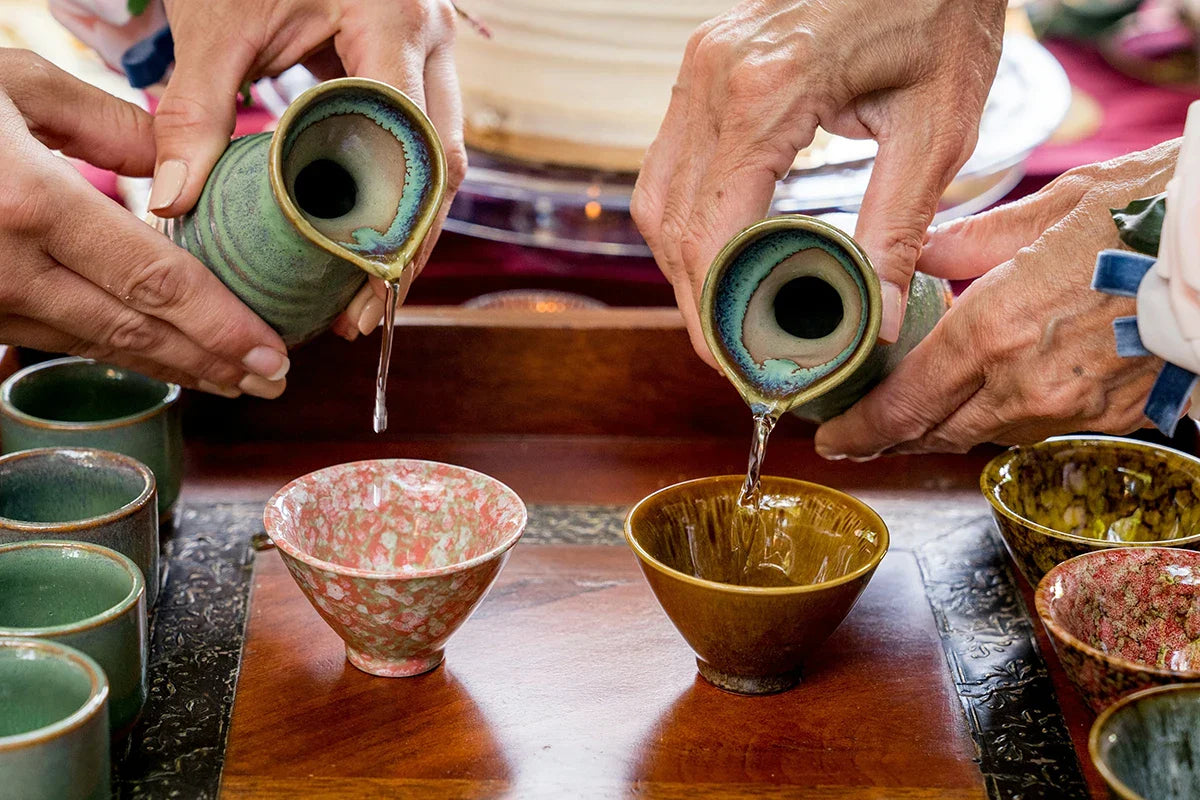
A traditional alcoholic Japanese drink, sake is made by a complex brewing process, and consists of rice, water, and koji.
Originating in Japan over two millennia ago, sake, often referred to as rice wine, holds a revered place in Japanese culture and cuisine.
From small village breweries to modern techniques refined by master sake artisans, the legacy of sake is steeped in craftsmanship and a profound appreciation for the delicate balance of flavours.
We love sake at The Wasabi Company, and have an extensive range for you to enjoy. In this blog post, we'll take you through the history, flavour, and production process of sake - so, soon, you'll be a sake expert!
Read on to find out more.

The history of Japanese sake
Sake's history spans centuries, rooted in ancient Japan where it was first brewed as a ceremonial offering to spirits. Over time, it evolved from a sacred ritual into a beloved beverage, brewed in sakagura, or sake breweries, across the country.
Through meticulous fermentation processes, brewers have been able to craft sake of increasing quality, exploring diverse flavour profiles that showcased the richness of Japan's rice and water sources. By continuing to innovate and experiment with their methods, brewers have paved the way for a huge range of sake types and flavours.
As trade networks expanded, sake found its way to the world stage. Today, sake remains a worldwide symbol of Japan's rich cultural heritage. Tradition is improved upon again and again to produce a drink that truly transcends borders.

The flavour of sake
The flavour of sake can change depending on a variety of factors, including its temperature, type, degree of aging, and filtration method. Chilled sake tastes light, fresh and fruity, whereas warm sake tastes full and sweet, with more umami.
Aged sake is a dark amber colour, and has a nutty, soy sauce-like aroma with a complex taste and roasted fragrance. A fresh, clear sake tastes fruitier. Most types of sake share a sweet, acidic, umami taste.
Sake production
Sake brewing and production is a meticulous process. Centuries-old tradition has been inflected with modern techniques to craft the beloved Japanese rice wine.
Making sake begins with the careful selection of premium rice grain varieties, such as Yamada Nishiki or Gohyakumangoku, which are polished to remove the outer layers, revealing the starchy core essential for fermentation. The polished rice is then washed, soaked, and steamed to prepare it for the brewing process.
In parallel, koji mould, Aspergillus oryzae, is cultivated on a portion of the steamed rice, converting its starches into fermentable sugars. This koji rice, along with yeast and water, is added to the remaining steamed rice in a fermentation tank, where multiple parallel fermentation occurs.
Over the course of several weeks, the yeast converts the sugars into alcohol, while the koji mould breaks down the rice starches. The resulting mash is pressed to extract the sake, which undergoes further filtration, pasteurisation, and aging before it is ready for bottling.
Whilst the fermentation process can produce a drink with over 20% alcohol content, it is usually adjusted to 15% to be more enjoyable for consumption.
This intricate process, overseen by skilled brewers known as toji, yields a diverse range of sake styles, each reflecting the unique characteristics of its ingredients, brewing methods, and terroir.

Our range of authentic premium sake
At The Wasabi Company, our delicious range of premium Japanese sake definitely contains one of your new favourites! From the distinctive Mountain Stream Junmai Nama to the floral the Hyakujuro "Sakura" Junmai Daiginjo, we have an extraordinarily diverse assortment of flavours for you to try.
Our favourite Junmai Daiginjo sake is made from a collaboration with Tatenokawa brewery and the Grammy Award-winning band Phoenix. For a zippy, fruity twist, try our sake with yuzu, our sake with umeshu, or our sake with ginger.
If you want a proper introduction into the world of sake, try our Sake Selection. It contains an extremely broad range of sake, including the elegant Konishi Gold (Daijingo), the light and fruity Stream (Junmai Daiginjo), the vibrant Sanko Hinokuchi "RAW" and the refreshing Yama Yuzu Shibori Sake.

Sakeware
Our beautiful collection of sakeware, including sake cups, sake carafes and sakeware sets, make a delightful addition to your dining table, as well as giving you an opportunity to enjoy sake in the best possible way.
They also make an amazing gift for any sake beginners, or a friend with a Japanese collection! Try this Sake Set with Stream sake and four cups.
As experts of sake, we're thrilled to introduce our customers into our world at The Wasabi Company. Do follow along to our blog for more information, and further insights into authentic Japanese cuisine.

